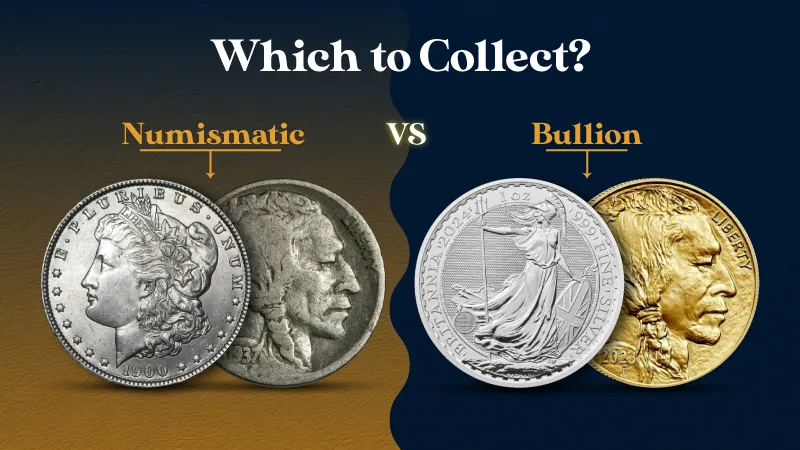Numismatic Coins vs Bullion: Which to Collect

By BullionMentor on December 7, 2023
In the world of precious metal investing and collecting, there are two main types of coins: bullion and numismatic. Bullion coins are mainly valued for their metal content, while numismatic coins can have extra value due to their rarity and designs. These coins can be composed of both gold and silver. Your choice depends on your investment goals and budget. Keep reading to learn more about numismatic coins vs bullion coins.
Numismatic Coins
Numismatic coins can be old or have very limited mintage, with intricate designs adding to their collectibility to collectors. These coins are highly demanded for their metal content, historical significance, rarity, and condition. Numismatic coins often have higher market prices compared to their metal value. Due to their collectible status, they often trade at prices above their intrinsic metal value. Numismatic coins were initially minted for general circulation.
There are some misunderstandings about silver and gold numismatic coins and the law that you should know about:
- It's incorrect to think that buying numismatic coins doesn't need reporting to the government. You must register the purchase of silver and gold, whether bullion or numismatic.
- Claims about coins minted before 1934 being exempt from government seizure are untrue.
- The idea that $20 gold pieces minted before 1934 are exempt from government gold seizure is false.
- There's a false belief that the law defines numismatic coins as those with a premium of 15% or more over their metal value.
- It's not true that the law defines United States $20 gold pieces as numismatic coins.
Bullion Coins
Bullion coins are struck with precious metals, such as gold and silver. They're generally made in smaller weights, 1 oz to fractional weights, which are parts of a troy ounce. For example, American Eagle gold bullion coins come in different weights from 22-karat gold. Other well-known gold bullion coins include the South African Krugerrands, Canadian Maple Leaf, and Chinese Gold Pandas. In the silver range, we have 2024 1 oz American Eagle Silver Coin (BU), 2024 1 oz Austrian Silver Philharmonic Coin (BU) etc.
Different countries have their official bullion coins. Some examples are the American Eagle from the United States Mint and the Canadian Maple Leaf from the Royal Canadian Mint. These coins have been around for thousands of years and used to be real money. But now, with the modern currency system, they are mostly seen as collectibles or investments. Investors buy bullion coins to protect their money from inflation. They see bullion coins as a way to keep their money safe, and their value can go up if regular cash loses value.
Are Bullion Coins a Good Investment?
Investing in bullion is a wise decision for any portfolio. It helps against inflation, protects during tough economic times, and grows wealth. But are bullion coins a good investment in the world of precious metals? Yes! Here's why:
- Bullion Coins Still Work as Money: Gold and silver coins can still be used to buy things, even though these are not a standard currency today. If financial systems fail, gold and silver can be the go-to currency.
- Variety: Bullion coins come in various designs, like the American Gold Eagle, Canadian Silver Maple Leaf, and more. Therefore, all coins with shapes, animals, or designs are available.
- Easy to Store: Bullion coins are simple to store securely and vital during economic downturns. However, keeping them safely, not at home or in a secret shoebox, is essential.
- Wider Acceptance: Bullion coins are more prevalent in international markets than bars because they are easier to trade.
Are Numismatic Coins a Good Investment?
Investing in silver or gold numismatic coins presents a range of benefits. Investing in rare coins can preserve and grow your wealth across generations. In the coin-collecting world, it's crucial to have a well-organized and patient approach. Collectors always search for unique and intricate coins. Willing to learn is key. Knowing what's happening in the coin market is also important; it can make your coin investments grow in value, even quickly. Here are the benefits of investing in numismatic coins:
- Higher Returns Over Time: Numismatic coin collections can provide better long-term returns than other investments such as bonds and stocks. Over the past 20 years, rare coins have shown strong results with less up-and-down movement. Comparing them to property, FTSE stock market investments, and gold, rare coins have nearly tripled the returns for investors.
- Historical Significance: Rare silver or gold numismatic coins are not just precious metals but pieces of art, tokens of history, and authentic collectibles. These coins have often traversed fascinating collections and witnessed the course of human civilization from antiquity to modern times. They offer a window into the growth and transformation of empires. It also reveals socio-economic parallels and connections that broaden our understanding of history.
- Attributes Affecting Price: The price of rare coins is influenced by several factors, including their artistic value, rarity, quality of preservation, and provenance. These features contribute to the desirability and value of a coin. Each coin tells a unique story, with artistic value, iconography, and individual authorship making them rare.
Example of Bullion Coins
Here are the top five gold and silver bullion coins for investment purposes:
British Gold Britannia
Manufactured by the Royal Mint in the UK, the British Gold Britannia is minted in 24 carats with a fineness of 999.9. Each coin has one troy ounce of gold. This is equivalent to 31.1035 grams. Importantly, they are VAT and capital-gain tax-free in Europe, making them a tax-efficient investment option.
Also, the British Gold Britannia bullion coins are available in fractional sizes for flexibility in your investment strategy. The latest 2022 release features advanced minting techniques and intricate designs that are hard to imitate or copy.
2024 1 oz American Eagle Silver Coin (BU)
The new release 2024 1 oz Silver Eagle is the most popular coin from the United States Mint. Made from 1 troy ounce of pure .999 fine silver, it's in excellent Brilliant Uncirculated condition. The front of the coin shows Lady Liberty walking with the sun rising behind her.
On the back, a solid American bald eagle is holding an oak branch. This design goes back to 1916. The coin is worth $1 in the United States. The US Mint guarantees that it's a real sovereign coin. This coin is the 39th American Silver Eagle suitable for Precious Metals IRAs.
2024 1 oz Austrian Silver Philharmonic Coin (BU)
Introducing the 2024 1 oz Austrian Silver Philharmonic Coin, a remarkable creation from the Austrian Mint. This coin is a tribute to Austria's rich musical heritage, notably the renowned Vienna Philharmonic Orchestra.
Struck in .999 pure silver, this coin c features the iconic Great Organ from Vienna’s Musikverein on its front. Its reverse comes with various orchestral instruments. It carries a legal tender value of €1.5 in Austria, backed by the government. This coin struck in Brilliant Uncirculated condition, is also eligible for precious metals IRAs.
South African Gold Krugerrand
Recognizable by its depiction of the springbok antelope, the South African Gold Krugerrand is a popular bullion coin internationally. Notably, more ounces of gold Krugerrand are in circulation than all other bullion coins combined. It was also the first coin to use gold as legal tender. Each Krugerrand contains 31.103 grams of pure gold, with a fineness of 916.7. These bullion coins are 32.77mm in diameter and 2.84mm in thickness.
Canadian Gold Maple Leaf
The Canadian Gold Maple Leaf is an iconic series of bullion coins celebrated for its innovative design featuring a detailed maple leaf. It is known for its security features and beautiful design, and it is made of.9999 fine gold.
This coin is incredibly popular in Canada and internationally. Each Canadian Gold Maple Leaf contains 31.103 grams of pure gold, with a fineness of .9999 (24 carats – fine). The coin has dimensions of 30mm in diameter and 3mm in thickness. Importantly, it is VAT-free.
Example of Numismatic coins
Old US gold coins, such as certain Saint Gaudens and $20 Liberty coins, are often considered numismatic coins. Moreover, American Eagle gold and silver coins are considered numismatic coins by law, as they were classified in 1985. Do not get confused with gold numismatic coins with collectible coins. Collectible coins are novelties sold for more than their metal value, and they usually don't become as valuable as numismatic coins. Examples of collectible coins are made by the Franklin Mint or modern ones from mints like the US Mint, Royal Canadian Mint, or Perth Mint. Some popular silver collectibles are Scottsdale Omnia Silver Round, Columnario Tribute Medal UHR Antiqued Silver Coin, Niue Cinderella's Story Antiqued Silver Coin (Color), etc.
Conclusion
When choosing between numismatic coins vs bullion, one must be well-calculated based on your investment needs. If you're an experienced coin collector with expert knowledge of rare coins and are patient enough to wait for their value to increase or for the right buyer to come along, investing in them might be a good choice. But if you're looking for a safer option to diversify your investments and plan for the long term, consider bullion coins in both gold and silver. Bullion Mentor shares valuable information to help investors make informed decisions. Stay tuned with us and get the correct data for navigating the world of precious metals.
FAQ's
- What are numismatic coins?
- What are bullion coins?
Numismatic coins are collectible coins that are no longer made and are limited in number. These rare coins have extra value beyond their metal worth, which depends on their unique qualities, age, and condition. Many coin collectors enjoy collecting rare coins for personal satisfaction rather than long-term investment.
Bullion coins, like gold and silver, are usually bought for three reasons: direct investment, protection against inflation, and personal coin collecting. These coins' prices depend on current precious metal market values and can change often. Many investors choose gold and silver bullion coins to diversify their portfolios for long-term wealth growth.
